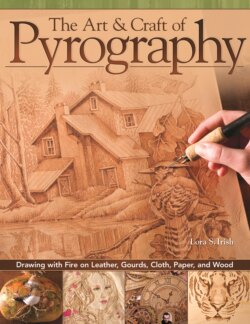Читать книгу The Art & Craft of Pyrography - Lora S. Irish - Страница 17
На сайте Литреса книга снята с продажи.
ОглавлениеScraping the tip with a special tool provided
by the manufacturer or with a sharpened knife can
quickly clean the tip. Emery cloth , fine steel wool, or
a woodcarving leather strop prepared with either red
oxide rouge or with aluminum oxide are alternatives.
For tracing:
•
Pencils
•
Colored ink pen
•
Carbon or graphite paper
•
Transparent tape
Two products used to transfer the design to
your work surface are carbon and graphite papers.
Both products are laid under your paper pattern
so that the transfer side is against your work surface.
Both should be used carefully as they are not easily
removed from your work surface after burning
is complete. Graphite paper, with its soft pale
grey coloring is especially appropriate for gourds,
papier-mâché, and darker woods.
You can also blacken the back of your pattern
paper with a soft pencil, covering it completely. Place
the pattern onto your work surface and trace over
the pattern lines leaving a fine line of pencil graphite
on your work surface. The pencil lines can later be
removed with a white artist eraser.
And generally…
•
White artist eraser
•
Transparent tape
•
Dusting brush
•
Old tooth brush
•
Assorted soft painting brushes
•
Ceramic tile or wood palette
•
Rulers and straight edge
•
T-square or right angle triangle
•
Cardboard
•
Canvas stretchers
•
Long quilter’s straight pins
•
Bench knife or utility knife
•
X-Acto knife
•
Small round gouge
Many common household items and tools are
used for pyrography to prepare the working surface,
secure your pattern, trace the design, and finish the
completed burning.
If you will be adding paint to your finished
burning you will need an assortment of soft bristle
brushes, a paint palette, water pans, and, of course,
the thinning medias whichever type of paint you
have chosen to use.
Bench knives or X-Acto knives can be used to
carefully carve away small mistakes in the burning
and to cut fine highlight lines into an area that has
already been burned. Some pyrographers also use
them as scrapers to clean the tool tips.
When working on cotton canvas you will want
several sheets of heavy cardboard and long quilter’s
straight pins to secure the cloth so that you are
working on a tight, non-moving surface. Canvas
stretchers can be purchased at your local art store so
that you can secure large pieces of canvas fabric.
Also include in your kit white artist erasers.
Please avoid pink erasers as they can leave pink
streaks of color on your work surface that is not
easily removed. The white eraser cleans up any left
over tracing lines and any oil or dirt from your hands
that builds up during a burning session.
Large dusting brushes are excellent to remove
the dust created during the preparations stage of
sanding your wood surface. Old toothbrushes can
also be used; they also are useful in removing any
excess rouge from your tool tips during preparation.
The Art & Craft of Pyrography
15
